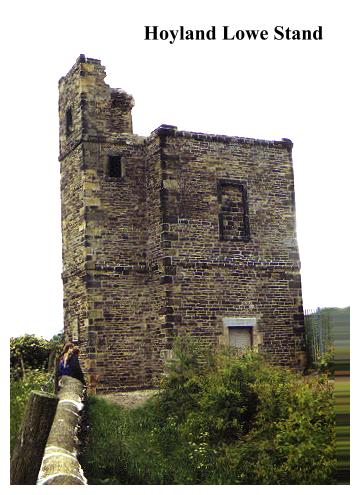



A restored and working watermill, a church with interesting monuments, an obelisk in incongruous surroundings, collieries in decline and a mysterious prospect tower are all to be found on this part industrial/part rural ramble through the landscape of the Barnsley Coalfield.
Getting there: Leave M1 Junction 36. follow A 61 through Birdwell towards Barnsley. Park Worsborough Mill, (3m S of Barnsley, 2m N of M1 jnctn 36) where there is a spacious (free!) car park. Distance: 5 miles. Easy enough, but beware of complaining children! Map Ref: SE 349 034 OS Huddersfield Sheet 102 1" series. Rating:Walk ** Follies and General Interest ** Note: Worsborough Mill open Wed - Sunday, 10 am to 5.30 pm.
Worsborough Mill is one of South Yorkshire's industrial archaeological gems. Standing on the banks of the River Dove, it is now incorporated into a 130 acre Country Park. The mill, after being in use for over 300 years closed down in the 1960's, only to be restored and re-opened as an industrial museum in 1976. It has a venerable pedigree. A corn mill at Worsborough is mentioned in the Domesday Book of 1086, and no doubt there was a mill here right down to the around 1625, when the present mill was constructed. The Industrial Revolution and the subsequent expansion of local coal and iron working increased demand for bread to such an extent that a second (steam powered) mill was added to the original complex in 1843. The decline of Worsborough Mill was brought about by the introduction of modern roller milling and the consequent change in public taste from stoneground to cheap, mass produced white flour. By the 1920's the steam engine had been scrapped and the watermill had been reduced to producing animal feed. Happily the recent restoration, along with the resurgence of interest in wholefood products has ensured that the mill is not only a living, working museum but also a thriving concern, selling the flour it produces. Today a Hornsby oil engine, built in 1911, drives the old steam mill, and this, along with the original waterwheel effectively demonstrates to children where our 'daily bread' comes from.
Our walk starts at the rear of rear of Worsborough Mill. Cross the bridge over the mill race and follow a track through the woods, with the reservoir on the right. Beyond, a stile and footbridge appears on the left,along with an area of boggy ground. Ignore this route (which leads up to the main road and Worsborough) and instead continue onwards, following a made up gravel path which leads through woods, passing a marsh on the left, to the embankment of the M1. Motorways are nasty, noisy places which have a habit of bringing out the worst in human nature- rudeness, bad manners, disregard for the safety of others and plain bloody mindedness! How amazing it is, therefore, to discover that lurking beneath the high embankments of this throbbing, humming artery of human insanity is a backwater of sylvan beauty, a habitat for birds, wild animals and flowering plants! The effect of building the M1 has been to bottle up water behind its earthwork base, and to produce a series of reed choked marsh-girt ponds, which make a perfect natural habitat for wildfowl. It seems that the M1 does some good after all! Now we follow a path along the base of the embankment with a reedy lake on the left. This leads through woodlands to join Rockley Lane by the Motorway underpass. Turn left and follow the Rockley Abbey/Wentworth Castle road which winds uphill , passing a motorway bridge and the Cock Inn to emerge into the A61 at Grimy Birdwell. The pits at Birdwell have gone, but what Worsborough has turned into an industrial museum Birdwell has turned into an industrial estate!! Red brick Birdwell straggles along the A61, an unlovely reminder that Barnsley's mucky past has not yet been totally consigned to photographs in history books. Where the Rockley Abbey/Wentworth Castle road joins the A61 at Birdwell we encounter our first folly- a tall obelisk, sited incongruously in a hauliers yard. Towering over the roaring carriageways of the M1 and surrounded by decaying vehicles, this must surely be the most unloved obelisk in Yorkshire!. The obelisk is, in fact, little more than a direction pointer. The carved inscription says "Wentworth Castle 3 miles 1775". Wentworth Castle, (not to be confused with Wentworth Woodhouse), is back down the road on which we came, and more follies may be found in its grounds (See appendix). At the obelisk turn right, along the busy A61, and follow to the road junction at the end of the village (Passing Yoga Centre on the right.). Turn left onto the A6135 Signed 'Chapeltown,Elsecar,Hoyland Nether'). The departure from Birdwell is uninspiring. The construction of industrial units has diverted the footpath, and the route leads behind them, knee deep in rubbish! A few yards beyond the junction , turn immediately left, following an untidy footpath behind an industrial site. At first stile stile turn right, and proceed across pastures to enter Cross Keys Lane from a particularly elusive stile. Cross the lane and continue onwards, following a signed footpath uphill, passing industry & allotments on the right. At a footbridge over a stream cross it and bear left up the inside of the fence (right of way), or alternatively simply follow the well defined path running along the side of the adjacent pit heap. Now we are back in a countryside of sorts ascending alongside the pit heap behind Hoyland Common. At the brow of the hill, turn right and follow the track to Hoyland Nether,emerging onto the B6096 opposite St. Peter's Church. Turn left, then beyond the cemetery turn left again, following a nettle choked path round the far side of the graveyard to Hoyland Lowe Stand. Hoyland Lowe Stand is, like all good follies, a total enigma. It is not at all clear who built it or why. With sightless bricked up windows, it is essentially a two storeyed square tower, with a higher stair turret, not unlike Boot's Folly (see Appendix). By all accounts it was built as a 'hunting stand'- a lookout tower connected with the chase. Pevsner gives a date of c.1720 but we get the feeling that he is merely guessing! The Stand is quite visible from the hillside above Elsecar, which suggests a possible association with the Marquis of Rockingham's follies at Wentworth Woodhouse, but then again the Stand is equally prominent when viewed from Worsborough. We are left with a mystery. From Hoyland Lowe Stand, continue downhill, bravely negotiating a path choked with jungle weeds and garden refuse which soon enters a metalled lane. Turn Left and pass through Upper Hoyland. Where the road bears left towards a derelict colliery by a farm, continue onwards, following a rough track down to a disused railway embankment. After crossing the disused railway line the path leads past filter beds to a wood and a stream, then ascends between hedges, finally leading up fields to meet a farm road at Hoyland Brook Cottage. Turn left along the farm track to enter Worsbrough village alongside the Church. Worsborough Village is a lovely place where the Barnsley blight seems remote, and we look back to the South Yorkshire of an earlier, pre-industrial age. The church (St. Mary's) is particularly worthy of exploration, despite the fact that the author found it locked on two separate visits! If you succeed in getting access you will find a fine Norman chancel and substantial 14th century work. There is a fine 18th century squire's pew, but the most striking feature of the church must surely be the 16th century monument to Roger Rockley. Dating from 1534, the monument is an unusual (and rare) example of the Tudor woodcarver's art. It is essentially a timber bunk bed! On the topmost bunk lies a carved effigy of Roger Rockley, resplendent in his armour, his hands clasped in prayer. and on the bottom bunk lies his withered cadaver, a carved skeleton in gruesome repose. Outside, in the churchyard these dire warnings continue, in a less spectacular, but no less interesting manner. On the N. side of the church a particularly gaunt gravestone bears the following legend:- In memory of JOSEPH BEAUMONT


